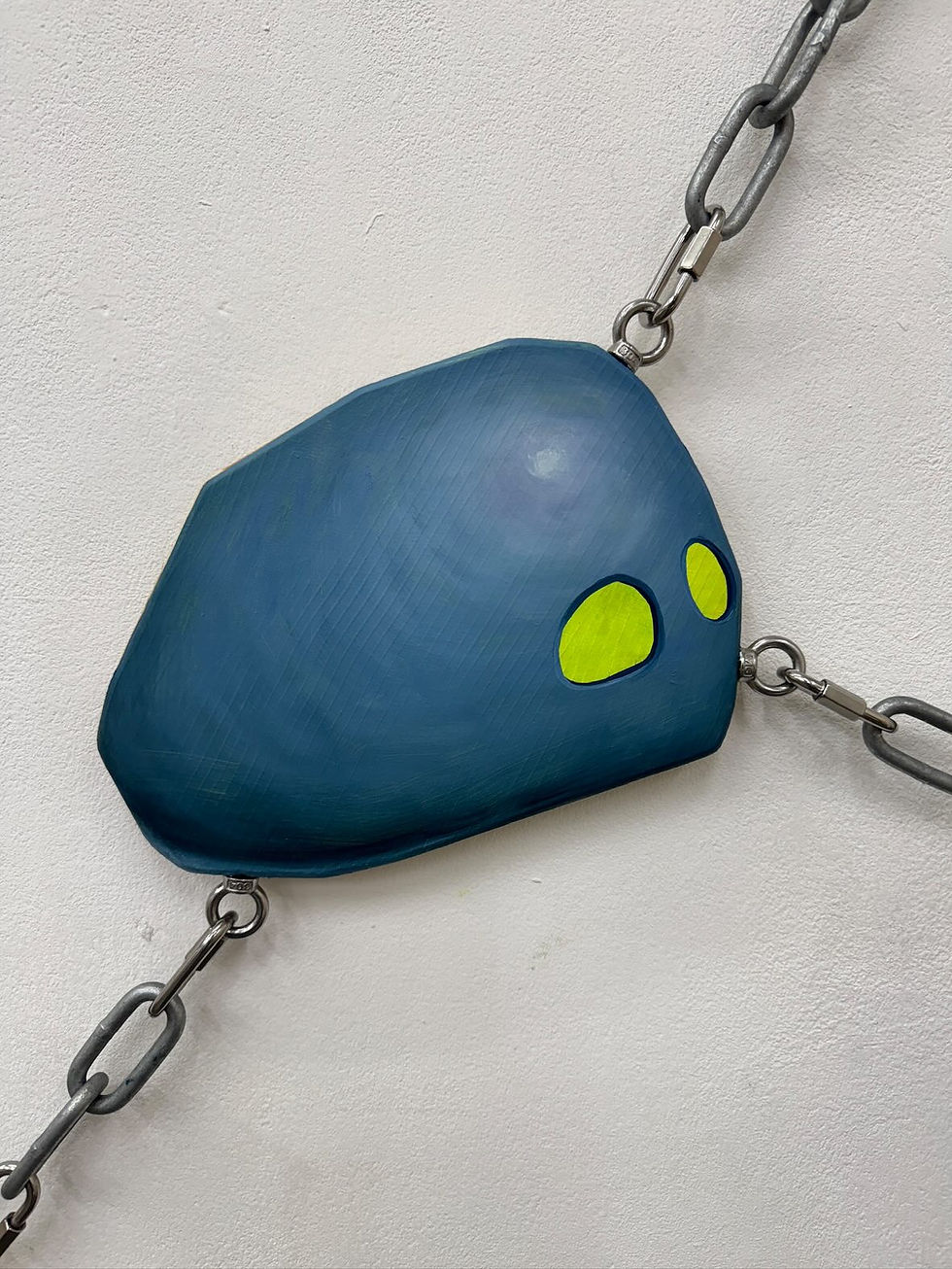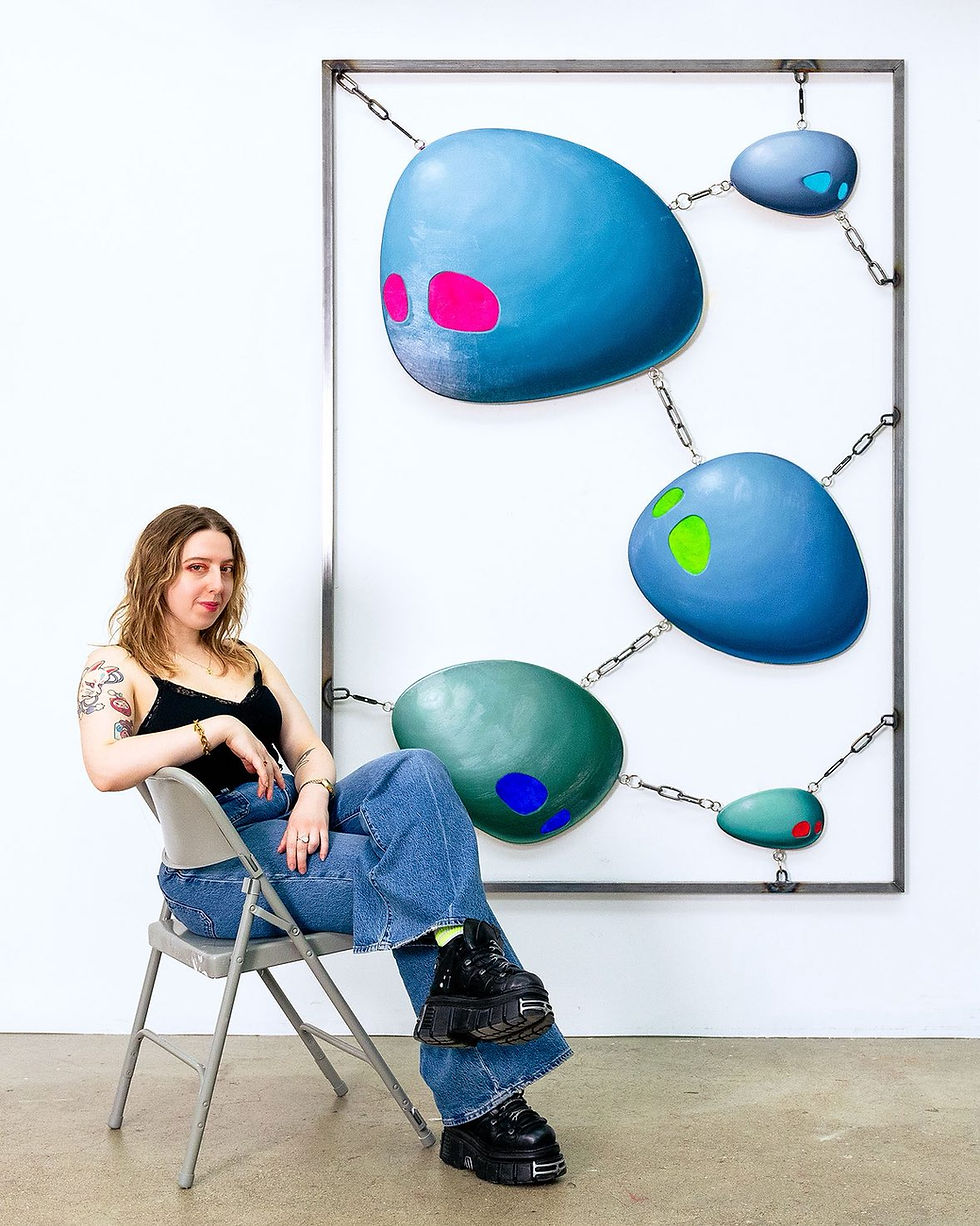Meet the Artist | Gemma Holzer
- Eleni Doulgeraki

- 21 hours ago
- 6 min read
Discover the vision of Gemma, a London-based artist whose practice fuses memory, mythology, and material experimentation. With a transatlantic upbringing and a foundation in both traditional and experimental techniques, she creates paintings that bridge natural and industrial worlds, populated by imagined figures that resonate with history, emotion, and narrative. In this interview, Gemma reflects on her evolution as an artist, her engagement with Neolithic sites and funerary art, and the innovative ways she approaches materials, space, and storytelling—offering a rare glimpse into the conceptual rigor and inventive spirit behind her work.
Visiting Gemma in her London studio provided a unique perspective on her process. Surrounded by works in progress and a thoughtfully organized space, it was immediately clear how deeply her environment, materials, and ideas are intertwined, revealing the meticulous yet experimental approach that defines her paintings.

Q1: Let's start with a little introduction—tell me about yourself and how you got started in art.
Gemma: My name is Gemma. I’m originally from the U.S.—I was born in the Bay Area, California—but I actually grew up in the Netherlands. My mom is Dutch and my dad’s American, so I spent most of my life there, and Dutch is my first language.
When I was 19, I moved to London to pursue art. Before that, I took a summer course at the Slade School of Fine Art called Contemporary Portraiture, and I absolutely loved it. That course was a turning point—it helped me realize art wasn’t just a passion, but something I wanted to do as a career.
I did a foundation year at the Art Academy near London Bridge. It was great because the structure allowed me to explore different disciplines. I focused a lot on photography at the time, which was my main medium.
After that, I did my undergrad at City & Guilds London Art School. I had a strong connection with the place from the moment I interviewed. It’s quite an intimate school—about 20 students a year—and the curriculum really emphasizes traditional techniques like life drawing and working from the National Gallery. Those first four years in London shaped me a lot, and I’ve stayed ever since.
Q2: You just completed your MA at the RCA. Was there a moment during your time there that changed how you approach your work?
Gemma: Honestly, the whole MA did that for me.
Before starting at RCA, my process was very specific—airbrush, tape, scalpels, clean lines, minimal oil paint. But when I got there, I made a decision to leave all of that behind and just experiment. It was scary at first! I didn’t work toward finished pieces at all that first term; I just explored.
I also took advantage of the workshops. I had barely done sculpture before, but in week one, before I even had my studio, I was welding in the metal shop. That opened up whole new ways of thinking—like how I could move paintings in space, incorporate chains and metal structures.
So yeah, stepping outside my comfort zone and exploring new materials made a huge impact. Conversations with peers and tutors also helped crystallize the ideas I already had in mind but didn’t yet know how to express.
Q3: Your work seems to exist between ruin and invention, past and future. How conscious are you of narrative while making it?
Gemma: I’m quite conscious of it, actually. I always carry sketchbooks—I've probably filled eight over the past year. They’re filled with drawings, notes, ideas—often inspired by readings, sites I’ve visited, or objects I’ve come across.
So by the time I’m painting, I usually have a solid idea of the composition and narrative. That said, I leave room for surprise, especially in color and brushwork. The physical act of painting still has spontaneity. But the concepts and forms are often built up over time.
Also, I work on several paintings at once. There’s usually a slow buildup from idea to execution, but then I finish several works at once and it feels like a burst of productivity.


Q4: Your work often blends natural and industrial elements. Is that a commentary on the world today?
Gemma: It’s not a critique, per se, but more of an observation. I’m really drawn to how quickly our environments change—especially in cities. Steel, for me, represents that rapid transformation. It’s heavy, man-made, and contemporary, especially next to the ancient rocks I reference.
But these materials also carry emotional weight. The steel and chains in my work can imply tension, restriction, or strain. In contrast, the rocks represent something ancient, spiritual, or remembered—but maybe forgotten too. There’s a softness in emotion, but a hardness in materiality that creates a tension I like to explore.
Q5: Your "creatures" or figures—do you see them as characters, symbols, or something else entirely?
Gemma: I think of them almost as idols from imagined histories—as if there were once mythologies around them. They never existed, but could have.
In a sense, they’re also self-portraits, especially when I paint a single figure. If there are two, it might represent a relationship; three could be family. I think a lot about numbers and their symbolism. Louise Bourgeois is a big influence for me in that respect.
I’m also really inspired by funerary art—objects made to hold the memory of someone who’s gone. They’re purposeful and intimate, but once those who knew the person are gone, the memory becomes inaccessible. That really resonates with me.
Some of the creatures have hollow eyes or slightly colored sockets—that’s intentional. It’s to suggest there’s something alive or soulful inside, but it’s unreachable, almost spiritual.
Q6: You’ve mentioned being drawn to Neolithic sites and standing stones. What kind of presence do they hold for you?
Gemma: I think a lot of my work comes from a deep anxiety about time passing and forgetting. Memory is so fragile—sometimes you’re just remembering the last time you remembered something, not the original moment. But these standing stones—they’ve been around for 5,000 years. They're physical proof of thought and intention by people whose lives we know nothing about, but who lived fully, just like we do.
They hold mystery and permanence. No one really knows why they were made—there are theories about burial, fertility rites, solar alignments—but no written record. Yet their presence still resonates. They were created with purpose.
I think we all want to leave something behind—some people do that through children, some through work or legacy. For me, painting these rocks, even though I find all the gray a bit tedious, gives me a way to hold onto something.

Q7: Can you talk about your recent exhibition and the people you collaborated with?
Gemma: The most recent show I was part of—and also helped organize—was called ‘’We’ve Been Here Before’’ at White Conduit Projects space. It was a four-person group show, quite intimate. Two of the other artists, Bbblob and Rachel Barlow, are peers of mine from the RCA Painting program. The fourth was my friend Coco Morris, who I’ve known since undergrad.
We also worked with Rhea Mehta from the RCA Curation department—she helped with the curatorial aspects, wrote the statement, and we all collaborated on the physical hang. It was a very organic process; we didn’t stick to traditional gallery rules like a fixed hanging height. Instead, we let the works interact and build on each other in the space, making the layout more fluid and visually interesting.
The show centered around themes like memory and layering—both physically and conceptually. It was a rewarding experience.
Q8: Do you have anything exciting to share with us from October or anything upcoming?
Gemma: Yes, October was a really exciting month. I took part in a few group shows—some with RCA peers and others I was selected for independently. One highlight was A Moveable Feast with Hypha Curates during Frieze Week (15th–19th October) at their Euston location, which was such a great experience. I was also part of Auto Amor Project Vol. 2, another really rewarding collaboration.
Looking ahead, I’m focusing on expanding more internationally. My work has already shown in parts of Europe and Asia, and I’d love to exhibit more in the U.S. I think the work could resonate well there—it’s colorful and playful, with a contemporary feel. The UK art scene can sometimes lean a bit more serious, which isn’t a bad thing, but not all of my pieces fit within that tone.


Gemma’s paintings offer a unique blend of memory, mythology, and material exploration, each piece inviting viewers into her vivid, thoughtfully constructed worlds. To experience her work firsthand and follow her latest projects, explore the links below—whether it’s her studio practice, recent exhibitions, or upcoming shows, there’s plenty to discover and be inspired by.
Links to her work:
All photographs belong to Gemma Holzer © Gemma Holzer







Comments